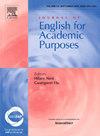研究医学视听幻灯片演示中语言-视觉模式的相互作用
IF 3.4
1区 文学
Q1 EDUCATION & EDUCATIONAL RESEARCH
引用次数: 0
摘要
本研究以台湾某医科大学学术写作课程26篇学生制作的视听幻灯片为研究对象。分析的重点是在这种格式中语言和视觉模式之间的互动,它的特点是预先录制的口头叙述与静态幻灯片同步。使用系统功能-多模态话语分析,确定了三种不同的呈现模式——基于幻灯片的、海报式的和基于文本的,每种模式都反映了学术话语特征和数字支持的不同配置。幻灯片和基于文本的格式往往依赖于密集的圣经视觉效果和语言视觉重复,而海报风格的演示则展示了更深思熟虑的视觉构图和修辞结构。虽然学生们表现出了新兴的多模态意识,但许多人在复杂的间义关系上挣扎,比如双名、下名和搭配。这些发现表明,学生正处于发展特定体裁的多模态读写能力的过渡阶段。本研究总结了支持连贯和修辞有效的多模态学术交流发展的教学意义。本文章由计算机程序翻译,如有差异,请以英文原文为准。
Investigating verbal-visual mode interaction in medical audio-slide presentations
This study examines 26 student-produced audio-slide presentations from an academic writing course at a medical university in Taiwan. The analysis focuses on the interaction between verbal and visual modes in this format, which features pre-recorded oral narration synchronized with static slides. Using Systemic Functional-Multimodal Discourse Analysis, three distinct presentation patterns—slide-based, poster-style, and text-based—were identified, each reflecting different configurations of academic discourse features and digital affordances. Slide- and text-based formats tended to rely on dense scriptural visuals and verbal-visual repetition, while poster-style presentations demonstrated more deliberate visual composition and rhetorical structuring. Although students exhibited emerging multimodal awareness, many struggled with elaborative intersemiotic relations, such as meronymy, hyponymy, and collocation. These findings suggest that students are in a transitional stage of developing genre-specific multimodal literacy. The study concludes with pedagogical implications for supporting the development of coherent and rhetorically effective multimodal academic communication.
求助全文
通过发布文献求助,成功后即可免费获取论文全文。
去求助
来源期刊

Journal of English for Academic Purposes
Multiple-
CiteScore
6.60
自引率
13.30%
发文量
81
审稿时长
57 days
期刊介绍:
The Journal of English for Academic Purposes provides a forum for the dissemination of information and views which enables practitioners of and researchers in EAP to keep current with developments in their field and to contribute to its continued updating. JEAP publishes articles, book reviews, conference reports, and academic exchanges in the linguistic, sociolinguistic and psycholinguistic description of English as it occurs in the contexts of academic study and scholarly exchange itself.
 求助内容:
求助内容: 应助结果提醒方式:
应助结果提醒方式:


